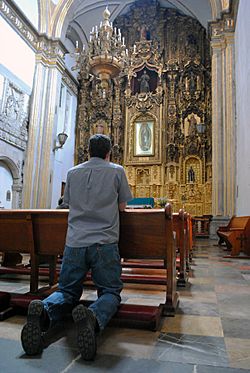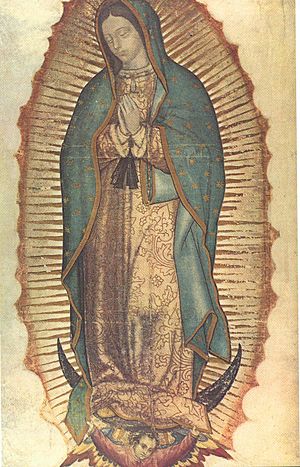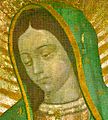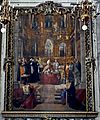Our Lady of Guadalupe facts for kids
Our Lady of Guadalupe (in Spanish: Nuestra Señora de Guadalupe) is a special name for the Virgin Mary. She is believed to have appeared on Tepeyac Hill in Guadalupe, a town near Mexico City. She is said to have appeared to a poor native American man named Juan Diego. Our Lady of Guadalupe is a very popular religious and cultural symbol in countries where Spanish is spoken. The Catholic Church celebrates her feast day every year on December 12. This date marks the anniversary of her appearance.
On February 8, 1887, Pope Leo XIII allowed the image of Our Lady of Guadalupe to be officially crowned. This crowning happened on October 12, 1895. Since then, the Virgin of Guadalupe has been called "Queen of Mexico," "Patroness of the Americas," and "Empress of Latin America."
Contents
What are Marian Apparitions?
Catholic stories say that the Virgin Mary appeared four times to Juan Diego. She also appeared once to Juan Diego's uncle, Juan Bernardino. The first time she appeared was on the morning of December 9, 1531. This was on the old Julian calendar. Today, it would be December 19. A Mexican farmer named Juan Diego saw a vision of a young woman. This happened at a place called Tepeyac Hill. This hill is now part of Villa de Guadalupe, a suburb of Mexico City.
The Virgin Mary's Request
The stories say the woman spoke to Juan Diego in his language, Nahuatl. This was the language of the Aztec Empire. She said she was the Virgin Mary, "mother of the very true deity." She asked for a church to be built on that spot to honor her.
Juan Diego then went to the archbishop of Mexico City, Fray Juan de Zumárraga. He told the archbishop what had happened. The bishop did not believe Juan Diego. But on the same day, Juan Diego saw the young woman again. This was the second time she appeared. The story says she asked him to keep trying to convince the bishop.
On Sunday, December 10, Juan Diego spoke to the archbishop again. The archbishop told him to go back to Tepeyac Hill. He asked Juan Diego to request a special, miraculous sign from the lady. This sign would prove who she was. That same day, the third appearance happened. Juan Diego returned to Tepeyac and met the woman. He told her about the bishop's request. She agreed to give a sign the next day, December 11.
Juan Diego's Uncle Gets Sick
On Monday, December 11, Juan Diego's uncle, Juan Bernardino, became very sick. Juan Diego had to stay and take care of him. Early on Tuesday, December 12, Juan Bernardino's health got worse. Juan Diego left to go to Tlatelolco. He needed to find a Catholic priest to help his uncle.
Juan Diego wanted to avoid the Virgin because he had missed their meeting on Monday. So, he chose a different path around the hill. But the Virgin stopped him and asked where he was going. This was the fourth appearance. Juan Diego explained what had happened. The Virgin gently told him he should have asked her for help. She said, "¿No estoy yo aquí que soy tu madre?" This means, "Am I not here, I who am your mother?" These words are very famous from the Guadalupe event. They are written over the main entrance to the Basilica of Guadalupe. She told him that Juan Bernardino was now well. She also told him to gather flowers from the top of Tepeyac Hill. This hill was usually bare, especially in cold December. Juan followed her instructions. He found Castilian roses blooming there. These roses were not native to Mexico.

The Virgin placed the flowers in Juan Diego's tilma, which is a cloak. When Juan Diego opened his cloak in front of archbishop Zumárraga on December 12, the flowers fell out. On the fabric of his cloak was the image of the Virgin of Guadalupe.
The next day, December 13, Juan Diego found his uncle fully recovered. The Virgin had told him this would happen. Juan Bernardino said that he had also seen her by his bedside. This was the fifth appearance. He said she told him to tell the bishop about this appearance and his amazing recovery. She also told him she wanted to be known as Guadalupe.
The Miraculous Image
The bishop first kept Juan Diego's cloak in his private chapel. Then he put it in the church for everyone to see. Many people came to see it. On December 26, 1531, a procession took the miraculous image back to Tepeyac. It was placed in a small chapel built quickly for it. During this procession, the first miracle is said to have happened. An Indigenous man was badly hurt in the neck by an arrow. It was shot by accident during a show to honor the Virgin. The people were very upset. They carried him to the Virgin's image and asked for his life to be saved. When the arrow was removed, the man quickly and fully recovered.
Juan Diego's tilma has become a very important religious and cultural symbol in Mexico. It has been widely supported by the church and by people. In the 19th century, it became a symbol for Spaniards born in America, in what was called New Spain. They felt the story of the apparition showed their own Mexican roots were important. It also helped them feel a sense of purpose and identity. This even helped them justify their fight against Spain.
Juan Diego was made a saint in 2002. His full name is Saint Juan Diego Cuauhtlatoatzin.
The Shrine in Spain
The shrine to Our Lady of Guadalupe in Spain was a very important Marian shrine in the medieval kingdom of Castile. It is one of many dark or black-skinned Madonnas in Spain. It is honored in the Monastery of Santa María de Guadalupe. This monastery is in the town of Guadalupe in Extremadura, Spain. Many Spanish explorers, like Hernan Cortes, came from Extremadura. The name Guadalupe is thought to come from an Arabic phrase. It means "Wad-al-lubb" or "hidden river." This is because the river gets narrow near the town of Guadalupe.
This shrine has a statue that is believed to have been carved by Luke the Evangelist. It was given to Saint Leander, the archbishop of Seville, by Pope Gregory I. Local stories say that when Seville was taken by the Moors in 712, some priests ran north. They buried the statue in the hills near the Guadalupe River. In the early 1300s, the Virgin appeared to a humble cowboy named Gil Cordero. He was looking for a lost animal in the mountains. Cordero said that the Virgin Mary had appeared to him. She told him to ask priests to dig at the spot where she appeared. The priests dug and found the hidden statue again. They built a small shrine around it, which grew into the large Guadalupe monastery.
Images for kids
-
The banner of the Mexican conquistador Hernán Cortés from year 1521, which was kept within the Archbishop's villa during the time of the Guadalupe apparitions
-
Painting Virgin of Guadalupe, c. 1700, featuring a crown on the Virgin's head, later removed. Indianapolis Museum of Art.
-
An 18th-century hagiographic painting of God the Father fashioning the image
-
Virgin of Guadalupe, September 1, 1824. Oil on canvas by Isidro Escamilla. Brooklyn Museum.
-
The altar image of Our Lady of Guadalupe with St. John the Baptist, Juan de Zumárraga and St. Juan Diego by Miguel Cabrera
-
The original tilma of Juan Diego, which hangs above the high altar of the Guadalupe Basilica. The suspended crown atop the image dates back to its Canonical Coronation on October 12, 1895. The image is protected by bulletproof glass and low-oxygen atmosphere.
-
Allegory of the papal declaration in 1754 by pope Benedict XIV of Our Lady of Guadalupe patronage over the New Spain in the presence of the viceroyal authorities. Anonymous (Mexican) author, 18th century.
-
The revolutionary banner carried by Miguel Hidalgo and his insurgent army during the Mexican War of Independence
-
Chapel of Our Lady of Guadalupe in the cathedral of Notre-Dame de Paris, Paris, France
-
Reliquary in the Cathedral of Our Lady of the Angels in Los Angeles, United States, containing a fragment of the tilma of Juan Diego
-
Representation of some indigenous (Aztecs) venerating the Virgin of Guadalupe in the Basilica
-
Altar in a market of Mexico City
See also
 In Spanish: Nuestra Señora de Guadalupe (México) para niños
In Spanish: Nuestra Señora de Guadalupe (México) para niños























